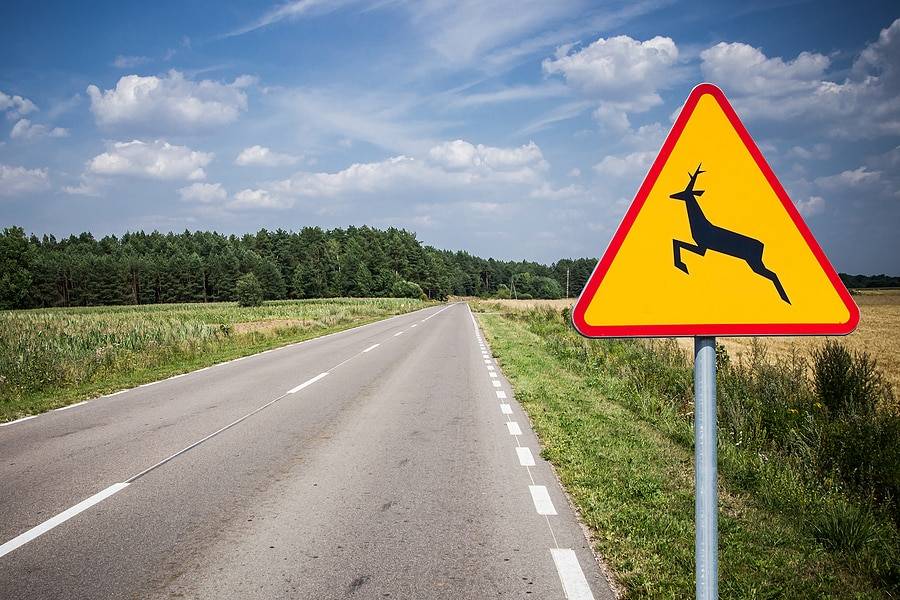Hitting a Deer - How to Avoid It and What to Do If It Happens

The presence of a deer in headlights might be more common than one would wish to be. On average, U.S. drivers have a 1 in 115 chance of a collision with an animal, most of which are deer. These accidents threaten wildlife survival and cause great danger to human lives and damage to their property. As unpredictable as auto-deer collisions may be, there are still some measures that you can take to help avoid such a traumatizing incident.
In this article, we’ve gathered some of the best tips and practices on how to avoid hitting an animal, and what to do if you accidentally hit one.
How to Avoid Wildlife-Vehicle Collisions Safely
When driving, you have very little time to react before an auto-deer collision could happen, as deer are typically hard to spot or come into your sight too late. So what can you do as a driver? The following tips and best practices may lend you a helping hand when traveling through deer-prone areas.
Be Aware of the Road Conditions
Always be an attentive driver and follow the rules. Take note of the “Deer Warning” signs on the road. Stay extra vigilant when driving through areas known for high deer activity or potential animal crossing. Rural roads, heavily wooded or forested roads provide more blind spots for deer or moose who leap out at passing drivers. So it’s vital that you adjust your driving speed in accordance with the road conditions and general traffic rules. In the event of an inevitable auto-deer collision, the impact will be worse if you’re going at full speed.

Stay Alert at Dusk and Dawn
Road traffic visibility gets poorer during the dusk and dawn hours. Unfortunately, wildlife especially deer are the most active during these early evening and morning hours. So it’s strongly advised that you reduce your speed when driving between dusk and dawn, and exercise caution throughout the journey. Use the high beams as long as there’s no opposing traffic for maximum visibility. Improved vision should help you spot the deer ahead sooner, so you have more time and distance left to react. If possible, pay more attention to the edges of the road where deer are more likely to jump out from.
Develop a “NOT to Swerve” Mindset
Keeping a watchful eye sometimes may not be enough. If colliding with a deer is impending, do not panic or let the “swerve” instinct kick in. Train yourself not to veer for deer, because you'll probably lose control of your vehicle if you swerve. No one is cruel enough to hit a deer on purpose, but colliding with another vehicle on the road or driving off the road into ditches can cause even more severe damage. Plus, deer are too unpredictable to veer for and you might still hit them even if you swerve. The best thing you can do is to honk your horn and use your brake(check the rearview mirror first of course), and hope the animal escapes in time. No matter how terrified you are, try to hold your wheel steady with both hands and stay in lane, which is the safest practice for both the vehicle occupants and the immediate drivers after you.
What to Do After the Collision?
First of all, take a deep breath and keep calm. As disturbing as the situation is, you must calm yourself down to prevent further damage. Usually, it was not your fault the collision occurred, but there’re quite a few important and urgent things that you have to deal with.
Pull Over and Check for Injuries
Pull over to the side of the road and get all vehicle occupants off the traffic. Turn your hazard lights on to make the car noticeable to avoid getting hit by another vehicle. According to a U.S. Department of Transportation study, there were no human injuries in over 95 percent of animal-vehicle crashes. So hopefully you and your passengers are not injured, but if any of you are, perform necessary first aid and call emergency services.
Contact the Authorities and Report the Collision
In most states of the U.S., you are legally obligated to call the police or park ranger to report any animal collision. Failing to do so could result in criminal charges and/or considerable fines. Therefore, you should contact your local police department to report the incident. Alert them if the deer you hit is blocking traffic and posing a threat to other passing drivers. If the collision causes injuries or property damage, you also need to fill out an official traffic report. This report can also prove helpful when filing your insurance claim.
Document the Accident with Details
After you’ve safely parked your vehicle, start taking pictures of the roadway, your surroundings, the wounded or deceased deer, damage to your car, and injuries to the vehicle occupants. Also, write down some general info such as date, location, road and weather conditions, etc, to help you tell an accurate story.
DO NOT Approach the Animal
Approaching an injured or seemingly dead animal can be hazardous. A frightened, wounded deer may still have enough strength to attack you with its strong legs and sharp hooves. It’s not your responsibility to inspect the deer’s injuries or try to offer medical care to the poor animal. All you can do for the deer is to patiently wait for the authorities to arrive and handle the situation, regarding the animal’s care, treatment, and cleanup of the scene.
Inspect the Vehicle for Damage
Double-check whether your car is safe to drive. You should fully examine your car even after a mild collision. Colliding with a deer or any large wildlife animal can damage different car parts. It’s not advised to automatically assume your car is still safe to drive. If the impact was major, start with checking for tire damage. Then look for any fluid leakage, loose parts or strange engine sound, shattered windshields, headlights, bent mirrors, broken hood latches, and door handles. There may also be hidden damage to the vehicle, such as the electrical systems, which are crucial to your car’s ability to function. If you have an automotive diagnostic scan tool kept in your vehicle, use it to do a full-system diagnosis. Scan for fault codes or module failures, which could be severe enough to render the vehicle unsafe to drive. If that’s the case, you should not continue driving it, instead, call for a towing service. After you’ve fully inspected and diagnosed the car for damage, contact the insurance company to start filling your claim.
Hitting a deer or any other wildlife animal can be very traumatizing, and you may feel guilty or anxious about it in the coming days or weeks. It’s perfectly normal to feel that way. You have every right to talk to someone, maybe a close friend, family, or therapist after the incident. We sincerely hope that everyone travels safely and never has to encounter an accident on the road.
